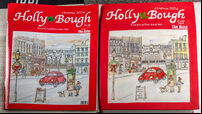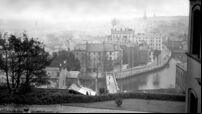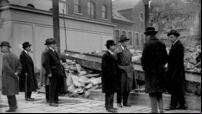Forgotten story of Cork’s Hegarty sisters and their role in the fight for independence

Jim Hegarty in the kitchen at The Laurels with his book.
When social entrepreneur and community advocate Maurice Dineen decided to make a short film about the Hegarty sisters of Pouladuff Road, Cork, it was primarily to celebrate the bravery, fortitude and determination of Nan and Mamie, and other women like them in Cumann na mBan, who played such a crucial role in Ireland’s fight for independence.
Nan and Mamie’s story, like many others who were actively involved in the War of Independence and the Civil War, was never talked about.
Inextricably intertwined with that of their brother, John Joe, and their homeplace, The Laurels, it is a story of determination, dedication, and devotion to a cause.
With its market gardens and ading shop, The Laurels was not only home to the Hegarty family, it also secretly served as a safe house for men on the run, a bomb factory, an arms store, an ammunition dump, an intelligence hub, and a brigade office for the IRA.
“As with many families of that period, their parents and grandparents were very much influenced by nationalism and were infused with the desire for the independence of Ireland from Britain,” writes John Joe’s son Jim Hegarty in his book, : .
“ers of their local Cork MP, Charles Stewart Parnell, in his quest for land reforms and independence, Patrick and Elizabeth Hegarty encouraged their children to believe in and strive for Irish freedom.”
John Joe and his sisters Nan and Mamie were all young IRA Volunteers who excelled in the use of weapons; organised military parades, drills, and marches; and attended meetings in the volunteers’ headquarters on Sheares Street.
The book describes how when the Conscription Act for Ireland was ed by the British House of Commons on April 16, 1918, the Hegartys (then aged 19, 22, and 24) ed those collecting money at church gates around Cork city, to help raise funds for the IRA to prevent the conscription of men into the British army during the First World War.
This campaign was successful, and conscription was never enacted in Ireland.
When the government offered a grant to those who got a qualification in first aid, both sisters applied for it and qualified, ostensibly so that they could attend to injured or wounded volunteers if and when required.
However, they also intended to use the grant to bolster the Brigade funds, “all in plain sight of the authorities they were working against.”
When the US navy established a base in Queenstown, now Cobh, following the sinking of the Lusitania and their entry into the First World War, Mamie’s fiancé John Forde, a fellow volunteer from H company, was working with a Cobh-based funeral parlour who had the exclusive contract of embalming the deceased American sailors and shipping them back to the US in lead coffins.
The book details how, as an embalmer, John laid out the deceased in full military uniform, complete with side arm. Before the coffin was closed, John used his privileged access to ‘redirect’ the deceased’s side arm to the Laurels which, by now, was being used as an ammunition and weapons dump.

It was also a bomb-making factory, making mostly tin-can bombs.
The ading shop provided a cover for the various activities being carried out by the loyal volunteers at the Laurels.
The market gardens too offered brilliant hiding spots for men on the run.
Waist-high trenches were also dug along the hedgerows, especially those bordering their sympathetic neighbours and friends, the Russell family.
Designed for easy access and escape, the hen run allowed further options of cover.
A bunker too was built under the potato pits to hide both arms and men. That way, when the Black and Tans or army prodded their bayonets into them, “they only hit what was above ground,” he told Jim.
“He also said they hid arms in the piggery,” adds Jim. “A very successful ploy, as the raiders were never anxious to thoroughly search it, for obvious reasons.”
As a market gardener, John Joe’s horse and cart were a familiar sight around the city, making daily deliveries of vegetables and fresh goods to markets and also, more importantly, to the local RIC barracks.
His unfettered access to places occupied by the enemy forces aroused no suspicions, allowing him to on any intelligence he gathered to his brigade commanders.
Meanwhile, Nan and the Mamie were also busy building up their networks, not only in Cork but further afield.
They were a vital cog in the Brigade’s overall intelligence network, providing information on British troops and RIC activity, and identifying British spies and suspected informers.
Thanks to the financial of her parents, Nan had effectively given up all career ambitions, devoting herself full-time to the cause and the work of Cumann na mBan.
She began “carrying parcels of arms, ammunition, and grenades and intelligence briefs dispatches between the Cork, Tipperary, and Limerick Brigades,” explains Jim.

When she travelled by train from Cork to Dublin for military manoeuvres, Nan often accompanied of Captain Sarsfield’s family. A military officer, Church of Ireland, and landowner, with clandestine sympathetic leanings to the IRA cause, he and his family, with their refined English accents, provided excellent cover as their carriage was never searched.
Nan, John Joe, and Mamie worked tirelessly for the cause.
While John Joe and others were carrying out raids, stealing arms, digging trenches and cutting phone lines to inflict maximum disruption to British travel and communications, Nan and Mamie were transporting ammunition across the city, gathering intelligence, helping those on the run, and more.
When Mamie and John Forde married at the Church of the Immaculate Conception, The Lough, their lives were in extreme danger as the groom was the first to be married in the Irish Volunteers Republican uniform and Mamie, then president of the Lehenagh Cumann na mBan, wore the old Irish national wedding costume, hand-embroidered by the Blackthorn House on Patrick Street.
The church was closed for the ceremony, which was officiated by Father O’Flynn, and sentries were posted around the church for their protection.
It was just a few weeks before the arrest of Lord Mayor Terence MacSwiney and the subsequent hunger strikes. Tensions were high.
Coincidentally, while director Catherine Mahon-Buckley, writer Elizabeth Scanlon, Jim Hegarty, and producer Maurice Dineen were in pre-planning with their production company Epic Productions, The Laurels house came up for sale.
“The Hegarty family managed to persuade the builder to allow us to use the house for the three weeks of filming. It was in a state of disrepair. But I’m a carpenter by profession, and I set about rebuilding two downstairs rooms, painting them, and hiring in the set,” said Dineen.
“It was incredible to stand in the house and on the original black and red floor tiles, the same ones that Nan, John Joe, and Mamie had walked on.”

The Hegarty siblings and their parents all played their part in the intelligence network and risked their lives on a daily basis. It can never be underestimated how important the intelligence gathering network, established nationwide by Michael Collins, was in securing independence.
What propelled them to keep going? That was the question Dineen asked himself as he told their story in the film.
At that time, ing on information about British authorities or their agents was as good as a death sentence to anyone caught.
The threat of instant military reprisals following the munitions strike or the threat of excommunication by the then Catholic Bishop of Cork, Rev Daniel Cohalan, did not even deter them.
Rather it spurred them on, and galvanised local for the cause.
Reliable intelligence work was vital, and one of the reasons for bringing the War of Independence to an end.
The State became almost paralysed and unable to function effectively as a result of the Irish intelligence network established under Collins, and kept alive by the incredible bravery of people like Nan, Mamie, and John Joe Hegarty.
- Resources: was written by Jim Hegarty.
- premiered at the Indie Cork Film Festival in October 2024.
- For more information on The Hegartys, check www.hegartycollection.ie.










